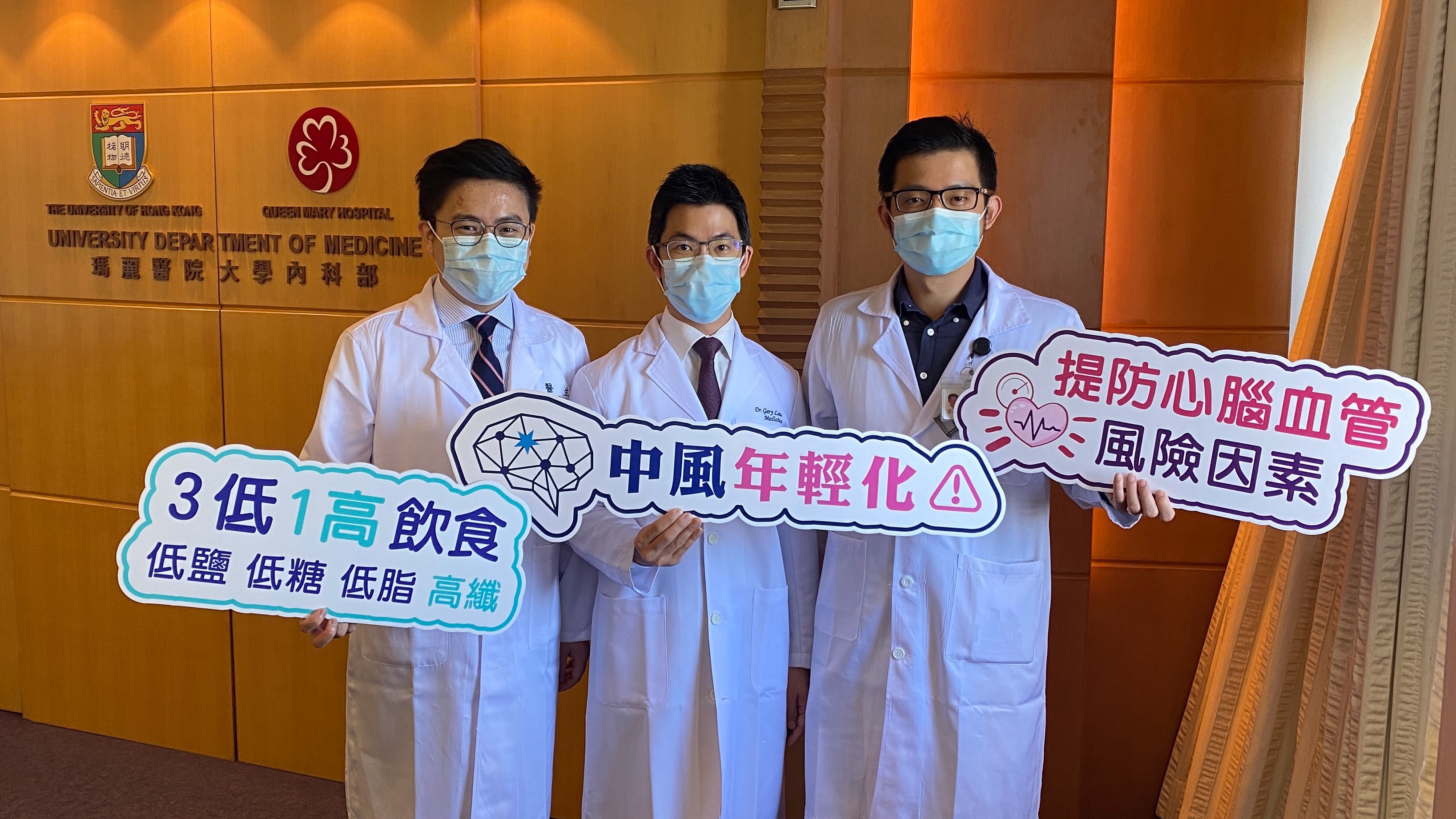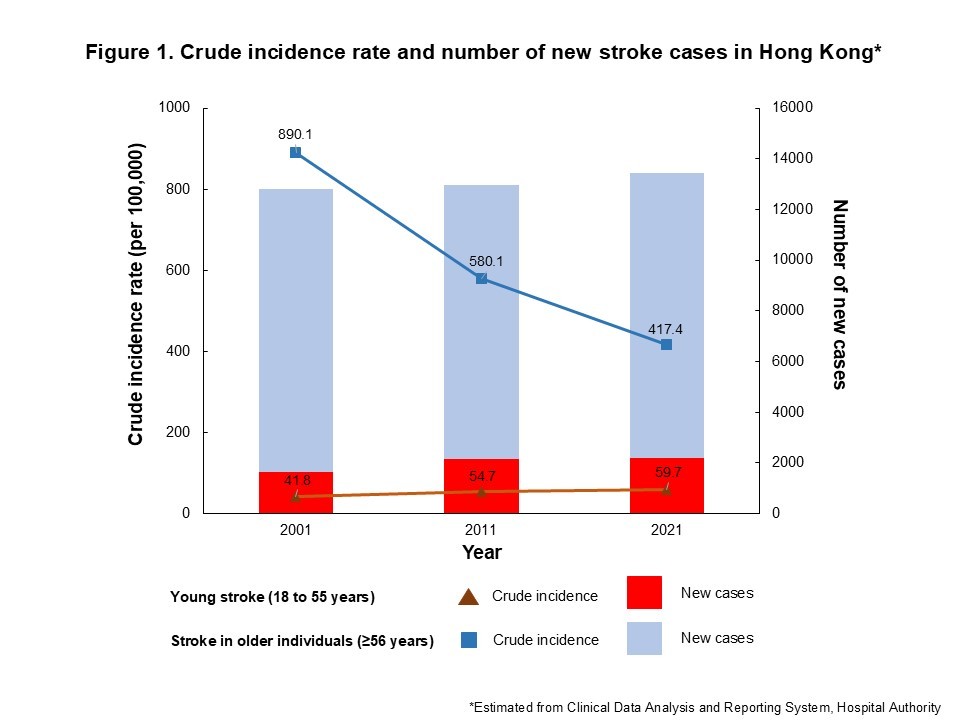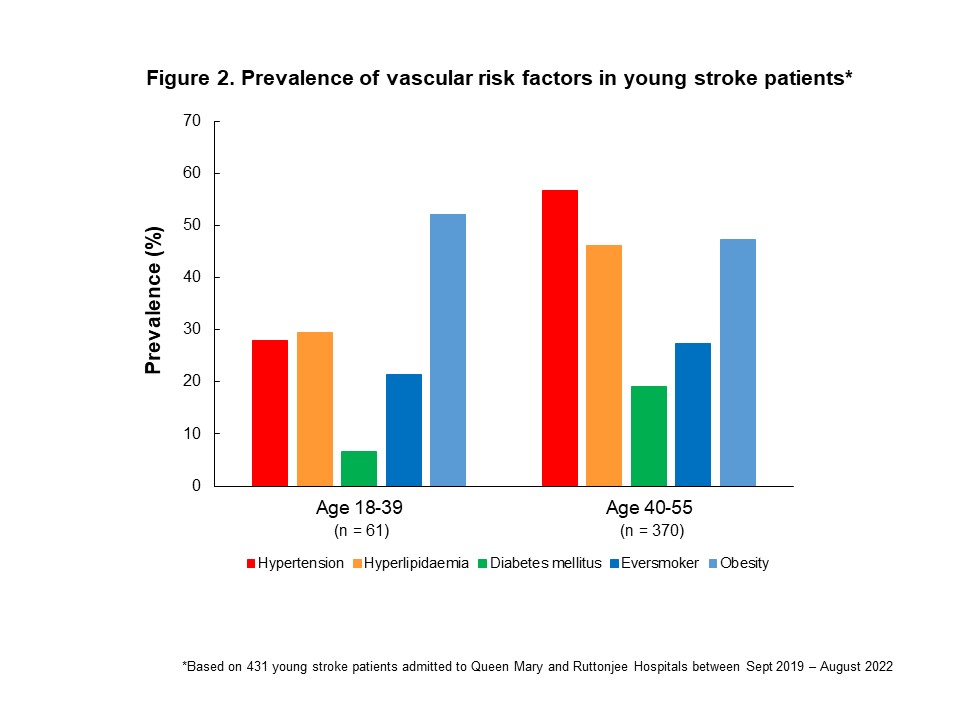27 October 2022
Researchers at the Stroke Research and Prevention Group (HKU Stroke), Department of Medicine, School of Clinical Medicine, LKS Faculty of Medicine, The University of Hong Kong (HKUMed) found that the incidence of ‘young stroke’ (strokes occurring in individuals aged 18 to 55 years) has increased by 30% in Hong Kong from 2001 to 2021, thus called for better control of vascular risk factors, in particular hypertension.
Research background and findings
Stroke is the second most common cause of death and a leading cause of disability in the world1. Although the overall incidence of stroke has declined in high-income countries2, the incidence of stroke among the younger populations has been rising globally3. However, the epidemiology of ‘young stroke’ in Hong Kong remains uncertain.
Using the Clinical Data Analysis and Reporting System of Hospital Authority, the research team analysed the trends of stroke in Hong Kong from 2001 to 2021 and found that the crude incidence of young stroke has sharply increased from 41.8 per 100,000 people in 2001 to 54.7 per 100,000 in 2011 and 59.7 per 100,000 in 2021 (Figure 1). Although the total number of new stroke cases admitted to hospitals under Hospital Authority remained similar at around 13,000 – 13,500 per year during the past 20 years, the number of young stroke cases increased from 1,634 in 2001, to 2,176 in 2021.
To identify the risk factors of young stroke, the study also followed up with a cohort of 431 stroke patients aged from 18 to 55 years who were admitted to Queen Mary Hospital and Ruttonjee Hospital of Hong Kong between September 2019 and August 2022. Among them, 53% had hypertension, 44% had hyperlipidemia, 26% had a smoking history, 19% were obese, and 17% had diabetes (Figure 2). Among those with hypertension, hyperlipidaemia and diabetes, 33%, 64% and 23% were newly diagnosed during the stroke admission respectively.
In a separate study, where 284 apparently healthy Hong Kong Chinese aged 40 to 65 years received 24-hour blood pressure monitoring, approximately 40% were diagnosed with hypertension. Their average daily sodium intake was estimated at 14g in men and 13g in women, far exceeding the World Health Organization’s recommendations of no more than 5g per day by 2.8 times and 2.6 times respectively. Moreover, it was noted that sodium intake strongly correlated with systolic and diastolic blood pressure as well as 10-year projected stroke risk.
Research significance
‘These alarming findings call for stronger awareness and control of vascular risk factors leading to stroke, especially among the younger generations,’ commented Dr Gary Lau Kui-kai, Director of HKU Stroke who leads the study. ‘Hypertension is the leading modifiable risk factor of stroke and previous studies have shown that with every 20mmHg increase in systolic blood pressure or 10mmHg increase in diastolic blood pressure, there is a 30-50% increased risk of stroke4. Consistent with other studies, our findings show that Chinese people tend to have a very high sodium intake, which is directly correlated with blood pressure and also projected stroke risk. Hypertension, hyperlipidaemia and diabetes are often the result of poor lifestyle and dietary practices and measures to control for these vascular risk factors through a better diet with significantly lower sodium intake, regular exercise and smoking cessation is strongly recommended for stroke prevention.’
Dr Lau further commented, ‘Our results are worrying as strokes are associated with a high chance of disability and death. Stroke also has profound psychological and social consequences. This is especially the case for young individuals, who are often bread-winners and need to take care of both older and younger family members. Our research also showed that approximately 30% of stroke survivors in Hong Kong suffer from moderate-severe depression, which is consistent with other studies5. The sociopsychological impact of stroke is thus far from negligible.’
FAST slogan
It is crucial for members of the public to know the symptoms of stroke, such that they could seek prompt medical attention when needed. Delays in seeking care or not seeking care for stroke patients could be detrimental. Time is brain and for every minute that stroke is not treated, it has been estimated that up to 1.9 million brain neurons may be lost6. Earlier treatment for stroke is associated with better outcome and any delay in seeking care would seriously jeopardise stroke patient’s eligibility for treatment. The FAST slogan is commonly used to remind the community of the symptoms of stroke and what to do when stroke is suspected. FAST stands for Facial weakness, Arm weakness, Slurring of speech and then it’s Time to call for help or dial 999.
About the research team
The research was conducted by a team led by Dr Gary Lau Kui-kai, Director of the Stroke Research and Prevention Group (HKU Stroke) and Clinical Associate Professor in Neurology, Department of Medicine, School of Clinical Medicine, HKUMed. The mission of HKU Stroke is to further understand what causes stroke, how to better prevent and manage it. HKU Stroke also strives to improve the well-being of stroke patients and their caregivers. For details, please refer to the website stroke.hku.hk.
- Stroke, Cerebrovascular accident, World Health Organization (www.emro.who.int/health-topics/stroke-cerebrovascular-accident/index.html).
- Li L et al. Trends in Stroke Incidence in High-Income Countries in the 21st Century: Population-Based Study and Systematic Review. Stroke 2020;51:1372-1380.
- Boot E et al. Ischaemic Stroke in Young Adults: A Global Perspective. Journal of Neurology Neurosurgery and Psychiatry 2020;91:411-417.
- Rapsomaniki E et al. Blood Pressure and Incidence of Twelve Cardiovascular Diseases: Lifetime Risks, Healthy Life-Years Lost, and Age-Specific Associations in 1.25 Million People. Lancet 2014;383:1899-1911.
- Hackett ML et al. Frequency of Depression after Stroke: A Systematic Review of Observational Studies. Stroke 2005;36:1330-1340.
- Saver JL. Time is Brain – Quantified. Stroke 2006;37(1):263-266.
Media enquiries
Please contact LKS Faculty of Medicine of The University of Hong Kong by email (medmedia@hku.hk).




Follow HKUMed